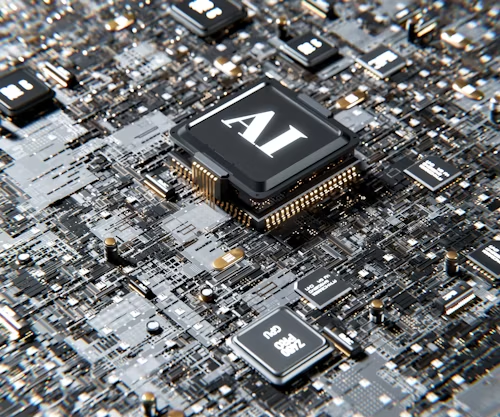AI Energy Consumption: How Much Energy Does AI Really Use and Should You Worry?

If you’ve been using tools like ChatGPT, image generators, or those clever AI assistants that seem to know everything, you might have wondered: How much power does all this actually take?
It’s a great question, and one more people are asking as AI becomes part of everyday life. The short answer: AI uses a lot of energy, but not always in the way people think. The good news? There are ways to make it cleaner and more efficient. Let’s talk about it below.
What AI Energy Consumption Really Means
When someone says AI uses a lot of energy, they’re really talking about what happens in huge data centers; those big warehouses full of computers that run day and night. Inside those centers, AI systems do two main things: training and inference.
Think of training like teaching a kid everything from scratch, except the “kid” is a computer model, and the “lessons” are billions of examples. It’s a one-time process, but it’s extremely energy-hungry.
Then there’s inference, that’s when the trained AI answers your question, writes your essay, or generates an image. That part uses much less power, but because millions of people use AI every day, it adds up fast.
So it’s not that every AI query is draining the grid. It’s the combination of massive training runs and constant daily use that matters.
Why AI Needs So Much Power
Let’s make it relatable.Training a big AI model is like powering a small town for a few weeks. That’s because researchers use thousands of powerful computer chips, all working at the same time, often for weeks on end.
When you or I ask a question, the energy used is tiny; roughly the same as keeping a light bulb on for a few seconds. But when billions of people do that daily, those “tiny” moments add up to something substantial.
And remember, it’s not just the computing that uses power; the machines get hot, so they need cooling systems, fans, and air conditioning. Keeping everything from overheating is a major part of the total energy cost.
Why the Numbers Seem Confusing
If you’ve been reading about AI energy consumption lately, you’ve probably seen wildly different numbers; some reports claim that artificial intelligence now uses more electricity than small countries, while others insist the impact is exaggerated.
The truth is somewhere in between, and it’s confusing because measuring AI’s power use isn’t straightforward. Some studies only count the energy used by the computer chips that train and run AI models, while others include the extra electricity needed for cooling, data center maintenance, and even hardware manufacturing.
On top of that, technology keeps improving, the chips and servers powering today’s AI are far more efficient than those from just a few years ago. The type of energy used also makes a big difference: one company might rely mostly on renewable sources like wind or solar, while another might still depend on fossil fuels, which increases its carbon footprint.
So, while the exact numbers vary, the overall trend is clear; AI’s electricity use is rising fast as the technology expands across more industries and daily applications.
Why It Matters for the Planet
All that electricity powering artificial intelligence has to come from somewhere, and that’s where the environmental impact of AI starts to show.
Most of the data centers that train and operate AI models still rely, at least in part, on fossil fuels, which means more carbon emissions are released into the atmosphere. This adds to the planet’s heat-trapping gases and contributes to climate change.
Beyond that, these massive data centers draw enormous amounts of power, sometimes straining local electricity grids and even driving up energy costs for nearby communities. It’s not just an environmental issue; it’s an economic one too.
Running AI systems around the clock isn’t cheap, and because energy is one of the biggest costs for tech companies, that expense can eventually affect what consumers pay for AI-powered products and services.
In short, the more AI grows, the more important it becomes to make sure that growth is powered by cleaner, more sustainable energy sources.
AI Energy Efficiency: How Artificial Intelligence Can Save Power
Here’s the surprising part, while AI is often criticized for its energy consumption, it’s also becoming one of the most powerful tools for saving energy. Many data centers now use AI-driven systems to monitor and control cooling automatically, cutting unnecessary power use by up to 30 percent.
Utility companies are also turning to artificial intelligence to predict electricity demand more accurately and to balance renewable sources like solar and wind, ensuring cleaner and more stable energy distribution.
Even in everyday buildings and homes, AI helps reduce waste by adjusting heating, lighting, and air conditioning based on real-time needs.
So, in a way, AI is both part of the problem and part of the solution; it’s like teaching technology to fix its own energy habits. As the industry continues to grow, using AI to make itself more sustainable might be one of the smartest things we can do for the planet.
How Tech Companies Are Reducing AI Energy Consumption
To make AI energy consumption easier to visualize, think about it like a car. Training a large AI model is like manufacturing the car; it requires a huge upfront investment of energy to build it.
Once the car is made, driving it (which is like running the AI, or inference) doesn’t use nearly as much energy per trip. But if millions of people are constantly driving every day, fuel use quickly adds up.
That’s exactly what’s happening with AI today: each individual request might use only a tiny amount of electricity, but multiplied by millions of users and applications, the total energy consumption becomes significant.
This analogy helps highlight why both the creation and daily use of AI matter when thinking about its carbon footprint and overall environmental impact.
What Tech Companies Are Doing About It
The good news is that major tech companies are aware of the energy impact of AI and are taking meaningful steps to address it. Many data centers are switching to renewable power sources like solar, wind, or hydroelectric energy, which significantly reduces their carbon footprint.
At the same time, companies are designing more efficient AI chips that use far less electricity than traditional GPUs, allowing the same tasks to be done with less energy. Engineers are also finding ways to compress large AI models so they require less computing power while still performing effectively.
Transparency is another important step, some firms are now publishing energy and carbon reports to show the public their progress toward sustainability. While these efforts don’t completely eliminate AI’s energy consumption, they demonstrate that improving energy efficiency is becoming a top priority in AI development, and it’s a trend that benefits both the planet and the industry.
What You Can Do as a User
You might think that your individual AI usage doesn’t make a difference, but it actually does; even small actions can add up to a significant impact.
For starters, be intentional with your prompts: instead of sending multiple short questions, try combining your thoughts into one clear query, which reduces the total computing time and energy used. You can also use lighter, on-device AI tools for simple tasks like grammar checks or basic calculations, since these require much less power than large cloud-based systems.
Supporting greener platforms is another way to make a difference; choose services that openly share their sustainability goals and energy efficiency practices. And don’t underestimate the power of spreading awareness; the more people understand the environmental impact of AI, the more pressure companies feel to adopt sustainable practices.
Just like recycling or conserving water, one person’s effort may seem small, but multiplied across millions of users, it becomes incredibly powerful in reducing AI’s carbon footprint.
What Governments Can Do
Governments also have a big role to play in making AI more sustainable. One of the most effective steps is requiring companies to be transparent about how much energy their AI systems consume, which helps track and reduce the overall carbon footprint of the industry.
Investing in renewable energy infrastructure is another key move, ensuring that as AI and data center usage grow, the electricity powering them comes from cleaner, sustainable sources. Policymakers can also fund research into energy-efficient hardware and algorithms, encouraging innovation that reduces power consumption without slowing technological progress.
Finally, governments can incentivize recycling and proper disposal of old hardware, cutting down on electronic waste and the energy needed to produce new equipment. With these strategies, public policy can guide AI development toward a future that’s both innovative and environmentally responsible.
Could AI Ever Be Green?
The idea of completely “green” AI might sound far-fetched, but it’s closer than you think. While no AI system can run without using any electricity, there are practical ways to drastically reduce its environmental impact.
One of the most important factors is cleaner energy; the more data centers rely on renewable sources like solar, wind, or hydro, the smaller the carbon footprint of every AI task. Smarter model design also plays a role: engineers are now training AI on smaller, more focused datasets and creating models that can be reused for multiple tasks, cutting down on the energy needed for constant retraining.
Finally, using AI efficiently avoiding unnecessary queries, optimizing prompts, and sharing resources, can make a big difference. When these strategies combine, AI doesn’t just become more powerful; it becomes far more sustainable, proving that technological progress and environmental responsibility can go hand in hand.
The Bigger Picture of AI Energy Consumption and Its Global Impact

While it’s easy to focus only on individual AI tools, the bigger picture shows that AI energy consumption is just one part of a much larger digital ecosystem. Data centers, cloud computing, streaming services, gaming, and even storing photos in the cloud all use substantial amounts of electricity.
The real challenge isn’t stopping AI or digital technology altogether; it’s making sure this growth is powered by sustainable energy and used efficiently. AI itself can actually help in this effort by optimizing energy grids, reducing waste, and improving efficiency in other industries.
Understanding AI’s overall energy footprint helps us make smarter choices as users, developers, and policymakers, ensuring that innovation can continue without putting undue strain on the planet.
Key Points to Remember About AI Energy Consumption
Here’s what you should keep in mind about AI energy use:
- Responsible growth is possible: AI doesn’t have to be harmful to the environment.Understanding its energy use and supporting efficiency and renewable energy, we can enjoy the benefits of AI from healthcare to education to creative tools, while minimizing its carbon footprint. Responsible growth is about balancing innovation with sustainability, ensuring that AI remains both powerful and eco-friendly.
- Training uses a lot of energy upfront: Building and teaching large AI models requires significant electricity, sometimes equivalent to powering a small town for several weeks. This energy isn’t just for the computing itself; it also powers cooling systems, storage, and the infrastructure that keeps everything running smoothly. The upfront energy investment is massive, but it’s a one-time cost that sets the foundation for all future AI use.
- Inference uses less per request, but adds up: Each time you ask an AI a question or generate content, the energy used is relatively small. However, millions or even billions of queries every day across the globe mean that these “tiny” amounts add up quickly, creating a noticeable impact on overall electricity consumption. This is why monitoring and optimizing inference energy is becoming increasingly important.
- Environmental impact depends on energy sources: The type of electricity that powers data centers has a huge effect on AI’s carbon footprint. Renewable sources like solar, wind, or hydroelectric power reduce emissions, while coal or natural gas increase them. Two companies running similar AI models can have very different environmental impacts depending on where and how they source their energy.
- Tech companies are improving efficiency: Many leading AI companies are actively working to make AI greener. They are switching to renewable energy, designing specialized chips that use far less power than standard GPUs, and compressing models so that they require less computing. These improvements not only reduce carbon emissions but also lower operating costs, creating benefits for both the environment and the business.
- Users can make a difference: Your daily AI habits matter more than you might think. Combining multiple questions into a single prompt, using lighter on-device AI tools for small tasks, and supporting platforms that prioritize sustainability can all reduce the total electricity AI consumes. Even small changes, when multiplied across millions of users, can make a meaningful impact on energy use and emissions.
- Policymakers play a role: Governments can guide AI toward sustainability by requiring energy transparency, investing in renewable energy infrastructure, funding research for energy-efficient hardware, and incentivizing proper recycling of old servers. These measures help ensure that AI growth doesn’t come at the cost of the planet and encourages responsible industry practices.






